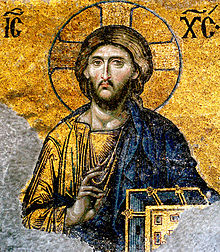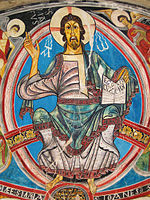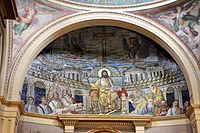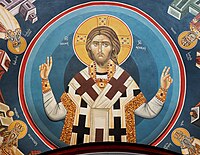Christ Pantocrator


In
The Pantokrator is largely an
When the
Meaning

The most common translation of Pantocrator is "Almighty" or "All-powerful". In this understanding, Pantokrator is a compound word formed from the Greek words πᾶς, pas (
Another, more literal translation is "Ruler of All" or, less literally, "Sustainer of the World". In this understanding, Pantokrator is a compound word formed from the Greek for "all" and the verb meaning "To accomplish something" or "to sustain something" (κρατεῖν, kratein). This translation speaks more to God's actual power; i.e., God does everything (as opposed to God can do everything).
Iconography

The icon of Christ Pantokrator is one of the most common religious images of Orthodox Christianity. Generally speaking, in Byzantine art church art and architecture, an iconic mosaic or fresco of Christ Pantokrator occupies the space in the central dome of the church, in the half-dome of the apse, or on the nave vault. Some scholars (Latourette 1975: 572) consider the Pantocrator a Christian adaptation of images of Zeus, such as the great statue of Zeus enthroned at Olympia. The development of the earliest stages of the icon from Roman Imperial imagery is easier to trace.[8]
The image of Christ Pantocrator was one of the first
The oldest known surviving example of the icon of Christ Pantocrator was painted in encaustic on panel in the sixth or seventh century, and survived the period of destruction of images during the Iconoclastic disputes that twice racked the Eastern church, 726 to 787 and 814 to 842. It was preserved in Saint Catherine's Monastery, in the remote desert of the Sinai.[9] The gessoed panel, finely painted using a wax medium on a wooden panel, had been coarsely overpainted around the face and hands at some time around the thirteenth century. When the overpainting was cleaned in 1962, the ancient image was revealed to be a very high-quality icon, probably produced in Constantinople.[10]
The icon, traditionally half-length when in a
Often, the
In many cases, Christ has a
-
The Pantokrator on the HungarianHoly Crown, c. 1075
-
Pantocràtor de Taüll, )
-
Christ Pantocrator mosaic from the dome of the Church of the Holy Sepulchre in Jerusalem
-
Christ Pantocrator inside the dome ofSt. Petersburg
-
Mosaic of Palatine Chapel in Palermo
-
Christ Pantocrator inside the Sacred Heart Church (Berlin), c. 1900
-
A miniature Russian icon of Christ Pantocrator, richly decorated with pearls and enamel, c. 1899–1908
-
Damaged mosaic of Christ Pantocrator inside the Kaiser Wilhelm Memorial Church, c. 1895
See also
- Christ the Redeemer
- Monumento al Divino Salvador del Mundo
- Salvator Mundi
- Transfiguration of Jesus
- Symbolism of domes
References
Footnotes
- Perseus Project
- ^ 2 Kings (2 Samuel) 7:8 and Amos 3:13
- ^ Job 5:17, 15:25 and 22:25
- Perseus Project
- Perseus Project
- ISBN 0-89870-514-2page 154
- ISBN 977-424-118-5page 92
- ISBN 0-7195-3971-4
- ^ Manolis Chatzidakis and Gerry Walters, "An Encaustic Icon of Christ at Sinai", The Art Bulletin 49.3 (September 1967) pp. 197–208.
- ISBN 0385171102
- ^ Otherwise the size of the figure would have to be greatly reduced to avoid the head appearing at the flattening top of the semi-dome.
Bibliography
- Latourette, Kenneth Scott, 1975. A History of Christianity, Volume 1, "Beginnings to 1500". Revised edition. (San Francisco: HarperCollins)
- Christopher Schonborn, Lothar Kraugh (tr.) 1994. God's Human Face: The Christ Icon. Originally published as Icôn du Christ: Fondements théologiques élaborés entre le Ie et IIe Conciles de Nicée (Fribourg) 1976
Further reading
- Chatzidakis, Manolis (September 1967). "An Encaustic Icon of Christ at Sinai". Gerry Walters, tr. The Art Bulletin 49.3, pp. 197–208.
- Galavaris, George (Jan 1, 1981). The Icon in the Life of the Church, 11. Brill Academic Publishers. ISBN 90-04-06402-8










